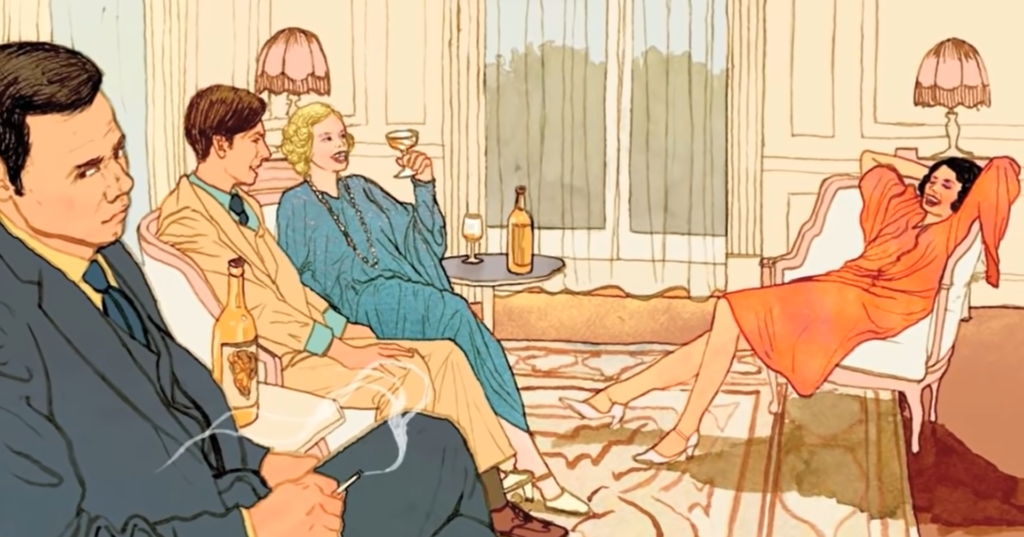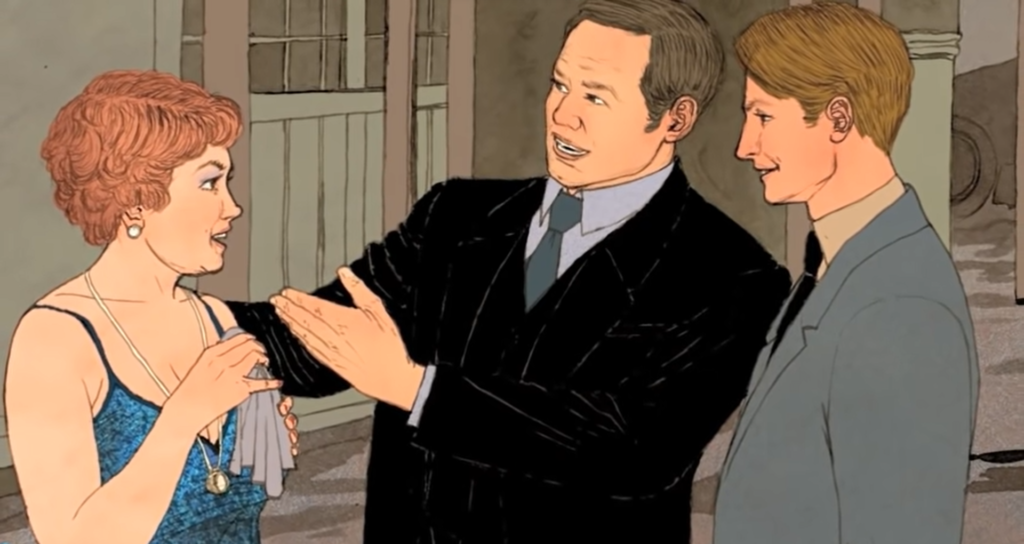F. Scott Fitzgerald’s classic novel, “The Great Gatsby,” is renowned for its rich symbolism and intricate exploration of themes. Among the various symbols and motifs employed in the novel, the color blue stands out as a recurring element that carries significant meaning. In this article, we will delve into the symbolism of blue in “The Great Gatsby” and unravel the deeper layers of interpretation.
The Blue Cover: A Prelude to Tragedy
- The encounter with blue symbolism in “The Great Gatsby” begins long before the reader delves into its pages, right on the cover itself.
- The first edition of this literary masterpiece presents a visually striking image that captures the essence of the story—a woman’s disembodied face set against a profound, dark indigo background.
- This iconic cover art, in many ways, serves as a metaphorical window, offering a glimpse into the very heart of the narrative.
Upon closer examination, the blue expanse of the cover reveals more than initially meets the eye. It unveils the iconic New York skyline, resplendent with its illuminated skyscrapers, creating a captivating juxtaposition with the woman’s enigmatic eyes. It is within these eyes that we discover the profiles of nude women, a subtle yet thought-provoking detail that hints at the depth and complexity of the world within the novel.
In essence, this blue cover transcends mere aesthetics; it emerges as a microcosm of Jay Gatsby’s life. Blue, within this context, takes on multifaceted symbolism, representing not only the vastness of life itself but also the deep melancholy that defines Gatsby’s unique narrative. On the surface, the cover showcases Gatsby’s wealth and extravagance, which are displayed ostentatiously. However, beneath this façade lies an undeniable truth—his riches are unable to fill the profound void left by the absence of his idealized love, Daisy Buchanan.
As the novel unfolds, Gatsby’s story leads us to a tragic denouement, a conclusion that starkly emphasizes the futility of his wealth and excess without the presence of the woman he adores. The blue cover, therefore, becomes a poignant and timeless symbol, an artistic harbinger of the alluring yet tragic undercurrents that permeate the narrative, leaving an indelible mark on the reader’s psyche and setting the stage for the profound exploration of themes within “The Great Gatsby.”
Blue Eyes of Dr. T.J. Eckelburg: The Watchful Observer
- A recurring and enigmatic symbol in F. Scott Fitzgerald’s “The Great Gatsby” is the piercing blue eyes of Dr. T.J. Eckelburg, prominently depicted on a towering billboard poster.
- These eyes, obscured behind yellow-rimmed spectacles, take on a profound and multifaceted significance within the narrative, serving as a representation of divine or higher observation.
- The deep blue hue of Dr. Eckelburg’s eyes resonates with themes of heaven, purity, and omniscience.
Throughout the novel, the characters, surrounded by the opulence and moral complexities of the Jazz Age, believe that these unblinking eyes “see” all of their actions. It’s as though they are under the watchful gaze of an omnipotent force. Remarkably, despite the characters’ perception that they are being scrutinized, Dr. Eckelburg himself remains a nonjudgmental observer, his passive gaze conveying the notion of impartiality.
In this context, the color blue takes on a broader and profound significance. It becomes a symbol for the overarching, watchful presence of a higher force, possibly akin to the concept of God, overseeing the actions and moral decline of the characters. Dr. Eckelburg’s eyes, framed by their yellow spectacles, become a potent reminder of the characters’ moral ambiguity and the consequences of their choices. The blue eyes, as a symbol of divine observation, serve as a powerful commentary on the moral and spiritual landscape of the era, highlighting the tension between aspiration and corruption that defines the lives of the characters in the novel.

Blue Water: Symbolism of Separation and Sadness
- In F. Scott Fitzgerald’s “The Great Gatsby,” water emerges as a ubiquitous and profound element, often cloaked in a distinct blue hue, weaving its symbolism into the very fabric of the narrative.
- Beyond its physical presence, water takes on a role that extends far beyond the boundaries of the physical world, embodying both physical distance and spiritual separation.
- At the heart of this watery symbolism lies Daisy Buchanan, the ethereal and unattainable love interest of Jay Gatsby, who resides across a vast expanse of water, thereby creating not just a geographical but also a profound emotional chasm between them.
This water, often depicted with a blue tinge, serves as a poignant representation of Gatsby’s enduring yearning and acute sense of loneliness. It becomes a symbol of his relentless pursuit of a dream that seems forever beyond his grasp, mirroring the evasive nature of his love for Daisy. The blue waters symbolize the unbridgeable divide that separates Gatsby from his heart’s desire, encapsulating his emotional isolation within the grandeur of the story’s setting.
As the narrative unfolds, a pervasive melancholy pervades the atmosphere. Fitzgerald’s evocative prose captures this mood masterfully, as he describes a “blue quickening by the window.” This moment occurs as Gatsby comes face to face with the harsh reality of his situation, a stark reminder of the impossibility of his dream. Here, the color blue deepens its association with sorrow, intensifying the theme that runs like a thread throughout the novel. Gatsby’s profound realization of the unattainability of his dreams becomes a poignant and heartbreaking moment, one that is steeped in the blue symbolism of sadness, accentuating the tragedy of his character and the ephemeral nature of his aspirations. In this way, water, with its enduring blue presence, serves as a profound and resonant symbol, underscoring the profound emotional landscape of “The Great Gatsby.”
The Blue Lawn: Wealth and Achievement
- Gatsby’s opulent parties in F. Scott Fitzgerald’s “The Great Gatsby” are nothing short of legendary within the novel’s world.
- These extravagant soirees unfold on a meticulously maintained blue lawn, an exquisite expanse of bluegrass that takes on profound symbolic significance.
- This manicured landscape serves as a visual representation of wealth and achievement, with the color blue itself symbolizing the opulence and abundance associated with extreme affluence.
The proximity of Daisy Buchanan, a character originally hailing from Kentucky, to this immaculate blue lawn further underscores the central theme of wealth and success in the story. Gatsby’s remarkable journey from humble origins to the pinnacle of opulence is encapsulated in the very symbolism of this perfectly manicured expanse of blue.
Yet, within this symbolic tapestry, a poignant irony emerges. Despite his tremendous material success, Gatsby’s relentless pursuit of happiness through wealth ultimately proves to be a fruitless endeavor. The blue, in this context, takes on a dual role: it signifies a form of perfection that, much like Gatsby’s pursuit of Daisy’s affection, remains forever elusive. The blue lawn stands as a testament to the unattainable nature of the perfection Gatsby seeks, serving as a poignant reflection of the fragility of his dreams and the hollowness of his achievements. In this way, the blue lawn becomes more than just a backdrop to the parties; it becomes a powerful symbol of the inherent complexities of wealth, success, and the pursuit of happiness in the dazzling yet ultimately disillusioning world of “The Great Gatsby.”
Blue Foliage: A Veil of Sadness and Failure

- In “The Great Gatsby” by F. Scott Fitzgerald, blue foliage and surroundings emerge as evocative symbols that envelop pivotal moments in the narrative, particularly in the aftermath of tragic events such as Gatsby’s death, Myrtle’s demise, and George Wilson’s despair.
- These instances are deeply steeped in a pervasive atmosphere of sadness and failure, and the prevalence of the color blue in these scenes acts as a poignant visual marker, underscoring the profound sense of disappointment and frustration that permeates the lives of the characters.
Gatsby’s inability to protect his loved ones and his persistent struggle to rescue Daisy from her tumultuous relationship with Tom Buchanan serve as recurring sources of sorrow within the story. The blue symbolism in these moments transcends mere aesthetics; it becomes a powerful and somber representation of the extreme sadness and heartache that Gatsby and those around him experience.
The blue foliage and surroundings, in their vivid portrayal, effectively shroud these poignant scenes in an aura of melancholy. They encapsulate the collective emotional weight of the characters, reflecting not only their personal failures but also the broader themes of disillusionment and unfulfilled dreams that define the narrative. As such, the color blue in these instances serves as a powerful visual and emotional motif, weaving together the threads of sadness and failure that run through the lives of the characters in “The Great Gatsby.”
Conclusion
In “The Great Gatsby,” blue serves as a versatile and powerful narrative tool. It encapsulates themes of dreams, wealth, separation, purity, and melancholy. Its multifaceted role enriches the story, offering readers a deeper understanding of the characters and their complex struggles in the pursuit of their desires.
As you immerse yourself in the world of Jay Gatsby and his contemporaries, the subtle shades of blue reveal a tapestry of emotions, aspirations, and tragedies. It is through this symbolic color that Fitzgerald paints a vivid and enduring portrait of an era and its characters, leaving an indelible mark on the landscape of American literature.
